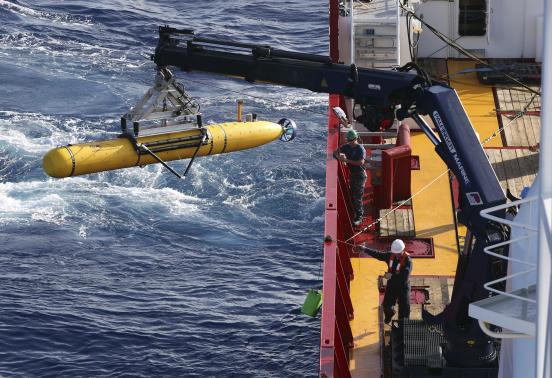(Reuters) – An underwater drone scouring the Indian Ocean floor for a missing Malaysian jetliner has dived to its deepest ever level, putting its equipment at unprecedented risk, as hopes dwindled that it might soon turn up some sign of wreckage.

ATTENTION EDITORS – THIS PICTURE WAS PROVIDED BY A THIRD PARTY. REUTERS IS UNABLE TO INDEPENDENTLY VERIFY THE AUTHENTICITY, CONTENT, LOCATION OR DATE OF THIS IMAGE. THIS PICTURE IS DISTRIBUTED EXACTLY AS RECEIVED BY REUTERS, AS A SERVICE TO CLIENTS. NO SALES. NO ARCHIVES. FOR EDITORIAL USE ONLY. NOT FOR SALE FOR MARKETING OR ADVERTISING CAMPAIGNS
The U.S. Navy’s Bluefin-21 and its side scan sonar has become the focal point of the search some 2,000 km (1,200 miles) west of the Australian city of Perth, where authorities believe Malaysia Airlines flight MH370 hit the ocean after disappearing from radars on March 8 with 239 people on board.
The search has centered on a city-sized area where a series of pings led authorities to believe the plane’s black box may be located. But after more than a week without a signal, and almost two weeks past the black box battery’s life expectancy, authorities have turned to the Bluefin-21.
But the Bluefin-21’s searches of the largely unmapped ocean floor have been frustrated by an automatic safety mechanism which sends it to the surface when it exceeds a depth of 4.5 km (14,763 feet). Its searches have yet to find any sign of the plane.
On Friday, as searchers waited for the remote-control submarine to return from its fifth mission, the U.S. Navy said the Bluefin-21 had gone to a record depth of 4,695 meters (15,403 feet) in its previous mission.
This is the first time the Bluefin-21 has descended to this depth, U.S. Navy spokesman Lieutenant Junior Grade Daniel S. Marciniak said in a statement.
Diving to such depths does carry with it some residual risk to the equipment and this is being carefully monitored by the U.S. Navy and (Bluefin-21 owner) Phoenix International.
He also confirmed that the Bluefin-21’s search area had been reduced based on further analysis of the initial signals believed to have come from the plane’s black box. Authorities have said the U.S. Navy’s previous estimate, that the Bluefin-21’s hunt may take two months, was also wrong and the drone was focusing on a reduced and more focused underwater search area.
NO END IN SIGHT
On Monday, the search coordinator, retired Air Chief Marshal Angus Houston, said the air and surface search for debris would likely end in three days as the operation shifted its focus to the ocean floor.
But on Friday, the Perth-based Joint Agency Coordination Centre said that up to 11 military aircraft and 12 ships would join in the search across 52,000 square km (32 square miles) of ocean. Marciniak said U.S. patrol aircraft continue to support the search effort.
That would suggest searchers, under pressure from the families of those on board the plane that was on a flight from Kuala Lumpur to Beijing when it disappeared, still hold some hope of finding floating wreckage.
Australian Prime Minister Tony Abbott was quoted by the Wall Street Journal on Wednesday as saying that we believe that (underwater) search will be completed within a week or so. If we don’t find wreckage, we stop, we regroup, we reconsider.
Asked by Reuters to clarify Abbott’s comments to the newspaper, his office said he was only suggesting that authorities may change the area being searched by the Bluefin-21 drone, not that the search would be called off.
Malaysia’s defence minister, Hishammuddin Hussein, vowed that the search would continue even if there could be a pause to regroup and reconsider the best area to scour.
The search will always continue. It’s just a matter of approach, he told a news conference in Kuala Lumpur.
He said Abbott remained in close contact with Malaysian Prime Minister Najib Razak and the two had spoken on Thursday to discuss the search.
(Additional reporting by Al-Zaquan Amer Hamzah in Kuala Lumpur; Editing by Michael Perry and Robert Birsel)





